Purchasing phones for your business is a big decision, one that’s complicated because there are so many options out there. Wireless VoIP phones are an excellent choice since you don’t have to deal with messy cables everywhere. Wireless phones offer limited portability, at least within the office.
But how do you know which one is the right option for your organization? Keep reading to find the best wireless VoIP phones in the market today.
What is a wireless VoIP phone?
Wireless VoIP phones work precisely as their name suggests. They can connect to the network and make/receive VoIP calls without the need for a wired ethernet connection. In every other respect, these phones are similar to the standard VoIP phones you can see in any office.
Wireless VoIP phones are not particularly hard to use either. The experience of making or receiving a call does not change. Most VoIP phone manufacturers emphasize the ease of use of their various VoIP phones. And your VoIP service provider will most likely help you if you run into any issues.
How to choose the best wireless VoIP phone
When you have a big decision to make, it’s helpful to break it up into smaller steps that are easier to accomplish. In other words, you need to simplify the purchase decision. In a world with dozens of wireless VoIP phones – and more released every day – you need a way to narrow down the list.
1 – Consider your budget
Wireless VoIP phones come in all shapes, sizes, and price points. From basic models at less than a hundred dollars to premium handsets that cost several hundred, there is no dearth of choices. But rather than worrying about a specific price for each phone, keep in mind your overall budget.
If you need the best range and features, even a small business can afford to splurge on a couple of high-end phones. But if you’re thinking of equipping the entire office of 200 employees with wireless VoIP phones, then the costs will add up. This is why a budget is important, rather than the price of each phone.
You can mix and match models as well. Consider buying a few top-end models for executives, 2 or 3 conference speakers for your meetings rooms, and more basic options for the rest of the staff. You may be surprised to find that some workers (salespeople for instance) don’t want a desk phone at all and are happy to use their mobile devices for business calls.
2 – Evaluate the must-have vs. nice to have features
There are many phones available that offer a superlative range, multiple technology options, the ability to add several numbers/handsets, and other features. But consider what your business needs versus the features that are nice to have but not dealbreakers. For example, a must-have feature could be a large screen with multi-function buttons for quick shortcuts. But if your staff is working in a small office, do you care about the phone having a wireless range of 300 meters?
The reason for evaluating the different features is to rank choices in order of suitability. Two phones at the same price may have completely different feature sets. Having a list of must-haves and wants will make it easier to eliminate options that don’t do what you need.
3 – Plan for the future
The third aspect to keep in mind is what you need today vs. what your business may require down the line. Your company might be a small 10 person organization today but in five years? You may have multiple offices and dozens of workers to consider. It pays to have growth in mind and plan for it accordingly.
Try to focus on a model that allows you to add more handsets and accounts or extend the wireless range should the need arise. That way you can start small with exactly what you need now and expand when necessary.
The bottom line is that you have to balance your needs with budget considerations and make sure you’re also planning for the future. After all, you don’t want to spend thousands of dollars on equipment that will become obsolete if you expand or change service providers.
What is the best wireless VoIP phone?
Having talked about what features you may want in your wireless VoIP phones, it’s apparent there’s no single ‘best’ phone out there. It mostly comes down to what is suitable for your needs and fits within the budget. That being said, here are a few models you should consider in searching for the perfect wireless VoIP phone in 2022.
Grandstream DP720: Excellent budget choice
It’s true that the best wireless VoIP phones don’t come cheap. After all, you pay for the quality and features they offer. However, that does not mean you need to spend hundreds of dollars to cover basic needs. This model offers quite a few features for the price (approx $60) including crystal clear HD audio quality, a must-have for any business phone.
While you can buy and use this as a standalone device, it shines exceptionally well when paired with the base station. The base can connect up to 5 devices and supports 10 different VoIP accounts. It also comes with call features like 3-way conferencing for remote collaboration with colleagues on-site, call forward, call waiting, call hold, etc.
The device is ideal for small offices with a wireless range of 50 meters indoors and 300 meters outdoors. It’s easy to use with clear navigation for the various menus and does not need any configuration if used with a Grandstream IP PBX.
Datasheet:
- Price: $60
- Key features: connect 5 devices and 10 accounts, excellent wireless range
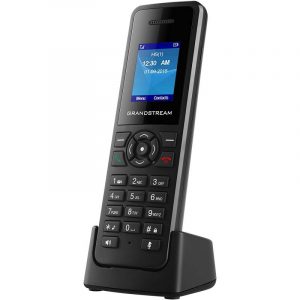
Snom 3098 M9R: Upgrade pick
If your budget allows and you’re looking for a more feature-packed model, Snom is always a good option and in this case the Snom 3098 M9R is a good choice. While it costs a bit more than the DP720, it also offers more flexibility. The M9R adapts well to many types of IP services and is designed as a plug-and-play device, using pre-configured profiles.
However, it also incorporates DECT technology which means you can use these devices as an internal intercom system should the need arise. You can add a DECT repeater to increase the range and the system uses a dedicated DECT frequency for clear audio on all your calls. The standard range is 50m indoors and 300m outdoors making it ideal for small to medium-sized offices.
The M9R allows up to 4 concurrent calls and you can add 9 handouts in total. The base is extremely small and lightweight, with just 2.2 pounds and a footprint of 9.5 x 3 x 8-inches. That means it’s small enough to hide away on a corner of your desk.
Additional features include color screen, mailbox, calendar, 3-way conferencing, call hold, call bridging, voicemail inbox, etc. You don’t have to worry about running out of charge while using the plethora of features either, the handset boasts more than 100 hours of standby time when away from the base.
Datasheet:
- Price: $105
- Key features: 9 devices, 4 concurrent calls, 100+ hrs standby time
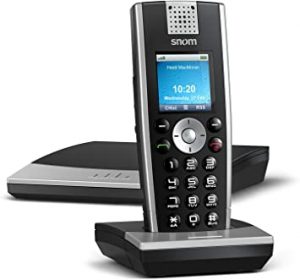
Grandstream GXV3240: Android-based VoIP phone
Businesses looking for more might want to consider Android-based wireless VoIP phones. The GXV3240 is one such device with many options thanks to the Android platform. You can download communication apps from the Play Store such as Skype or even manually install the firmware to support Microsft Teams.
Interested in connectivity options? The phone offers Bluetooth, a USB port, an SD card slot, and even a mini-HDMI port if you want to hook up a display or monitor. Since it’s built on Android, you can easily transfer calls from Android devices like mobile phones or tablets. With a built-in browser for quick searches and a capacitive screen, it’s a phone designed for modern businesses.
Unlike many other devices, it offers 6-way audio calls and 3-way video calls thanks to the 1-megapixel onboard camera. Users should consider this as a versatile multimedia workstation rather than just a wireless VoIP phone. If your staff is used to smartphones, then the GXV3240 is the perfect desk companion.
Datasheet:
- Price: $105
- Key features: Android platform, video conferencing, echo cancellation
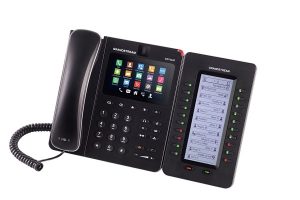
Yealink SIP-T58A: Great Android phone for video calls
While the GXV3240 is a good phone, it’s not perfect. If your business uses video calls extensively, then you need a better option. The T58A is an excellent device if you’re interested in video capabilities. Thanks to the large screen and a 2-megapixel onboard camera, the organization can fully utilize video calls.
The first thing that catches your eye with this phone is no doubt the screen. The large 7-inch HD quality screen offers plenty of real estate for video calls and any apps you download. That’s right, this is another Android-based wireless VoIP phone that makes even better use of the large screen. You can also move the screen for a better angle, which you may have to do often since it’s susceptible to glare quite often.
With HD quality audio and video, this is an excellent phone if you plan to replace in-person meetings with remote options. The past 2 years have shown that the traditional office may be gone forever, with more workplaces pursuing remote work. For businesses that plan to continue work-from-home options, the T58A is an excellent choice. There’s even an alternate version that supports Microsoft Teams if that’s what your company uses. Although pricier than the other models we’ve seen so far, it’s well worth it.
The phone does have a large footprint, so if space is a premium you may want to look at other options. If video calling is important and space is not a concern, this is a great video calling device that’s worth stretching your budget.
Datasheet:
- Price: $280
- Key features: Android platform, 7-inch HD screen, 2-megapixel camera
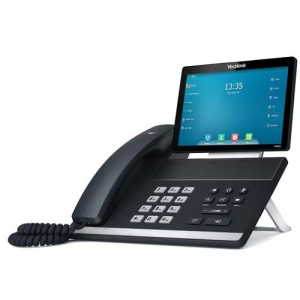
Cisco SPA525G2: Mobile friendly and reliable
No list of best wireless VoIP phones is complete without a Cisco phone making the cut. The SPA525G2 is a powerful option that comes jam-packed with features. Perhaps the biggest one is that it plays nice with Android smartphones. Unfortunately, many Android-powered VoIP phones don’t work very well with Android smartphones but this Cisco model does. It allows you to quickly transfer calls to your mobile and even share contacts easily.
With preconfigured profiles, this phone doesn’t need a lot of effort to set up. Any time you add a new employee or want to move the location, you can do so in minutes rather than days. This model supports 5 active lines, with each one using a different virtual number or sharing the same number with multiple devices.
It also offers extensive connectivity options including Bluetooth, wi-fi support, optional Power over Ethernet (PoE) which means fewer cables altogether. You can even use the screen to display RSS feeds or business photos. This particular model can also use the Cisco expansion modules allowing up to 32 programmable buttons for quick actions. Overall it’s a solid device at a price point that most businesses can afford.
Datasheet:
- Price: $150
- Key features: Android platform, video streaming, mp3 playback, mobile support
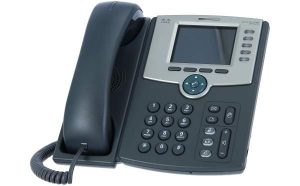
Spectralink 8440: Upgrade pick for remote teams
The phones on this list so far have focussed heavily on small to medium-sized offices with moderate standby time and wireless range. What if you’re looking for a robust and durable option for remote teams or staff working onsite? The Spectralink 8440 is a great option, albeit expensive. However, this phone offers powerful features for dynamic environments.
The device itself is durable, reliable, and made with high-quality components. Calls are crystal clear with two battery options. The smaller battery offers 8 hours of talk time while the bigger one allows for 12 hours of talk time and over 120 hours on standby. If your staff often works at client sites or other noisy environments, then this phone is an excellent choice.
The 8440 offers many advanced call management features including:
- Call hold and resume
- Call transfer
- Group call pickup
- Conditional call forwarding
It also supports up to six telephone lines as well as 3-way conferencing for remote collaboration. If you’re looking to connect multiple project teams or your staff and customers the Spectralink 8440 is a great option. Skip this phone if you’re looking for a more basic or budget-friendly model.
Datasheet:
- Price: $610
- Key features: reliable and robust, 6 phone lines, advanced call management
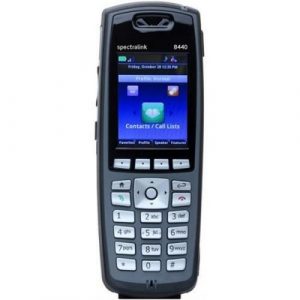
Obihai Gigabit OBI1062: The best option for concurrent calls
A consideration when buying wireless VoIP phones is the number of concurrent calls you can make. In a small office, you can be reasonably sure that not everyone will use the phone at the same time. So you can get away with devices that support 5 – 6 concurrent calls. But for larger offices and even smaller call centers, you need support for more.
If your business is looking for such a phone, then the Obihai Gigabit OBI1062 is a good choice. With a whopping 24 concurrent calls supported, you need not worry about long call queues for customers trying to contact you. As long as the office has a fast and stable internet connection, you don’t lose audio quality on calls either. You can also use this model as a conference phone since it has a built-in amplifier to enhance audio.
This option is ideal for medium-sized businesses and regular meetings with 8 programmable keys and built-in support for a 5-way conference bridge. Audio quality and echo cancellation are excellent, so others may not even realize you’re using the speakerphone to talk to them. With a small footprint and high-quality hardware, the OBI1062 is a great buy at $120 if you need more concurrent calls.
Datasheet:
- Price: $120
- Key features: 24 concurrent calls, an amplifier for speakerphone, built-in conference bridge for 5-way calls
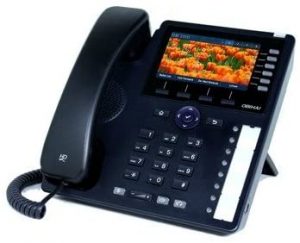
Panasonic KX-TGP600: Extendable range for larger office
Like many other phones on this list, the Panasonic KX-TGP600 has a base station and a handset. Setup is quick and easy, requiring no knowledge or previous experience. It can support up to 8 handsets when paired with the base station. Each handset can have a unique number or you can connect multiple devices to the same phone number.
Like the Snom M9R, you can use repeaters to extend the robust range of the base station. The system supports up to 6 repeaters, which means you can ensure coverage even in remote corners and several floors. The handset has 11 hours of talk time and almost 200 hours of standby time, so you’ll spend less time charging the device.
If you run the occasional team meeting or online training session, the 3 – way conference feature will come in handy. If you don’t have much desk space, you can even mount the base unit to the wall as there are no messy cables to hide. Whether you use phone service from a third-party provider or manage your system locally, this Panasonic model can be configured with ease.
Datasheet:
- Price: $170
- Key features: extend the range with repeaters, 8 concurrent calls, wall mounting option for the base unit
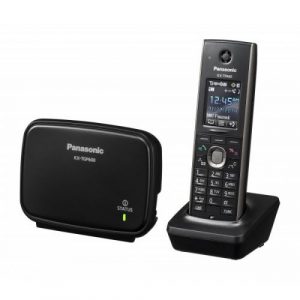
RTX8660 IP DECT Base Station + RTX8630 Handset: Option for large organizations
So far most of the wireless phones on the list have been suitable for small teams, with a few models (using repeaters) for larger physical spaces. But what if your office already has 50 – 100 employees and expansion is on the horizon? The RTX8660 base station + RTX8630 handset is the solution for your office.
This system offers repeaters so you can extend the wireless range to a large area. Additionally, you also have the option to connect up to 40 base stations together and build a much bigger system when you need it. That means you don’t need to buy more devices than you need today but it offers scope for expansion and growth tomorrow.
Since the base station is compatible with the RTX8830 and RTX8430 handsets as well, you can choose different models based on user requirements within the same office. Boasting a color display, a large phonebook, and almost 200 hours of standby time, this RTX system is a great choice for growing businesses.
Datasheet:
- Price: $450 for 1 base station and handset
- Key features: extend the range with repeaters, support 200 users with 40 base stations
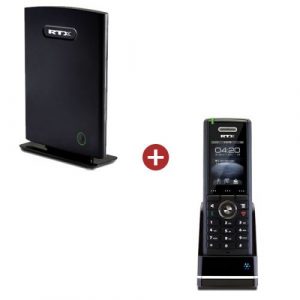
VTech VDP650 + VDP658 + VDP651: Multiple handset choices
The VTech VDP650 system functions similarly to the RTX above. It comes with a base station you can pair with either the VDP658 or the VDP651. The base can connect up to 10 handsets with a range of 500 feet. The 658 handset provides good quality audio without interfering with other devices because it uses DECT rather than other wireless protocols. It also comes with backlit keys, making it easy to sue in low light.
The second handset you can pair with the base station is the VDP651. Unlike the 658 which takes up quite a bit of space on a table, this is a much smaller cordless handset. Equipped with 4 LED-backlit keys and HD quality audio, it’s a cost-effective way to add new users to your system.
Datasheet:
- Price: $140 for VDP658 and $85 for VDP651
- Key features: backlit keys, programmable function keys, up to 1 week of standby time
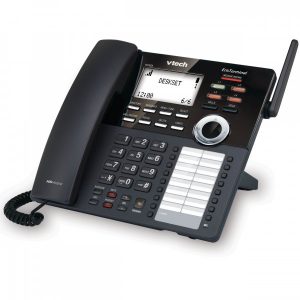
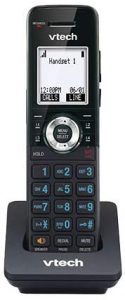
Wireless VoIP phones offer mobility and flexibility. But remember that they rely on your network for audio quality and to make calls reliably. That means you need a robust corporate network that handles the system. If this is not possible or you have dead spots within the office (warehouse, basement, etc.) consider using wired ethernet connections.
Wireless phones are the way to go if bandwidth and network traffic are not an issue. With no cables to worry about and how easy it is to set them up, there’s no need to hesitate.
For more information about the devices and accessories that best suit your needs, please visit VoIPstudio.


